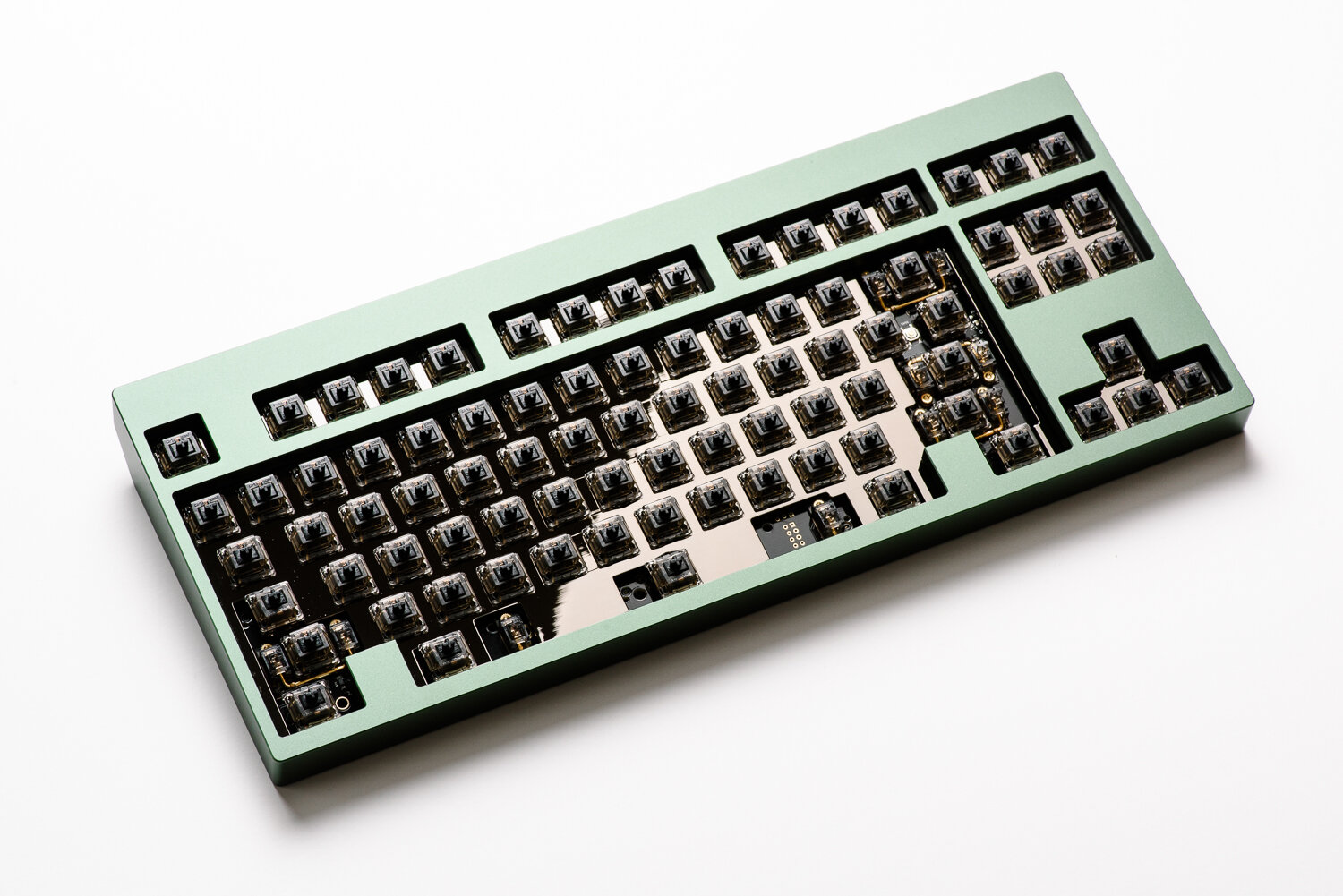Mode Eighty review
Since emerging late last year, Mode Designs has established itself as an up-and-coming manufacturer and vendor in the custom keyboard world. Their first offering, the Mode Eighty, is a premium TKL with a clean and professional-looking design. It also introduces a new construction style called “stack mount,” which has proven to be slightly controversial due to its use of foam as a necessary structural component. Read on to find out how the Eighty stacks up and if it makes for a great typing experience!
Specs
Form factor – TKL WK (87 keys) or WKL (84 keys)
Construction – stack-mount (Poron foam)
Case – CNC 6063 aluminum with anodized and/or electrophoresis finish
PCB – solder or hotswap (south-facing, 5-pin), USB-C via daughterboard, VIA/QMK support
Plate – aluminum (only included option); FR4, POM, polycarbonate, carbon fiber, PVD brass (purchased separately)
Stabilizers – PCB-mount (not included)
Pricing – $470/$480 (anodized, solder/hotswap), $480/490 (e-white, solder/hotswap)
Availability – pre-order
Disclaimer – I received the Eighty from Mode Designs for review. I have no financial arrangement with them, and all opinions are my own.
Introduction
The Mode Eighty was first revealed to the world in September 2020 on the “Interest Checks” section of Geekhack. Interestingly enough, the thread was removed by moderators since the keyboard was ready for sale and should’ve been filed under the “Group Buys and Pre-Orders” section instead (which would’ve required additional forum history for Mode to post in). As a result, the original Mode Eighty thread no longer exists for posterity. Apart from this minor hiccup, the keyboard release was rolled out in three stages – the Founder’s Edition, the First Edition, and the standard edition.
The Founder’s Edition came first as a limited run of 50 keyboards with polished PVD rose gold bottoms. These were priced at an eye-watering $690 but were in-stock and ready to ship. The majority of these units were sold via raffle and Vickrey auction. The Founder’s Edition was only available with a dark grey or silver top in WK configuration and a solderable PCB.
The First Edition was released next in a batch of 450 keyboards with silver chrome or dark chrome bottoms. These were sold for $640/650 at the end of October, in-stock and ready to ship like the Founder’s Edition. This time around, hotswap was introduced as an option, but buyers were still limited to dark grey or silver tops in the WK configuration.
In November 2020, the standard edition was made available for pre-order. In a move that would dramatically reduce the lead times to fulfillment, Mode began production of 1000 units prior to opening sales. Pricing this time came in at a much more palatable $470-490, with a variety of configurations – six different colorways, WKL/WK tops, and hotswap/solder PCBs. Mode began fulfilling pre-orders at the end of January 2021, and most buyers received their boards in early February 2021.
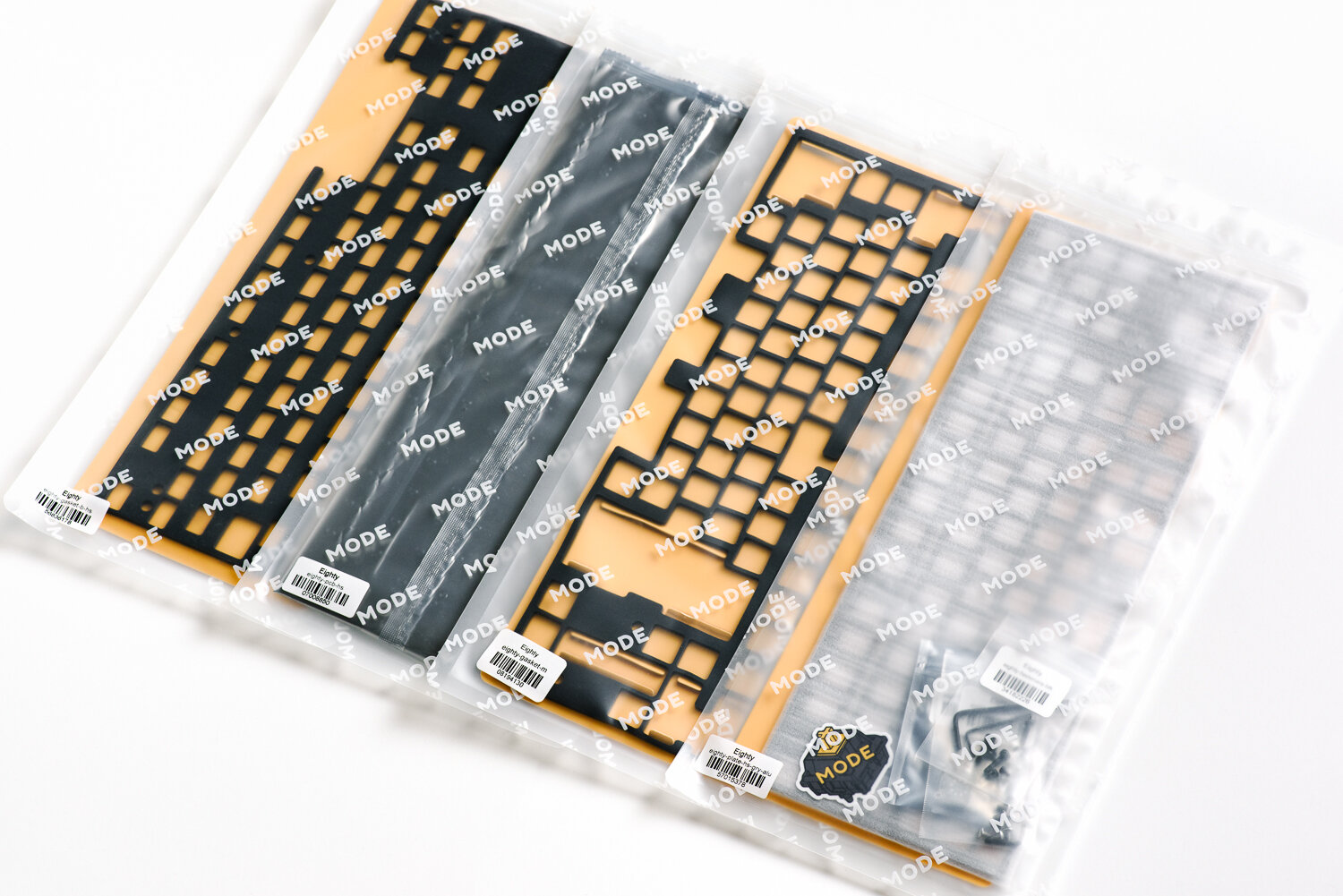

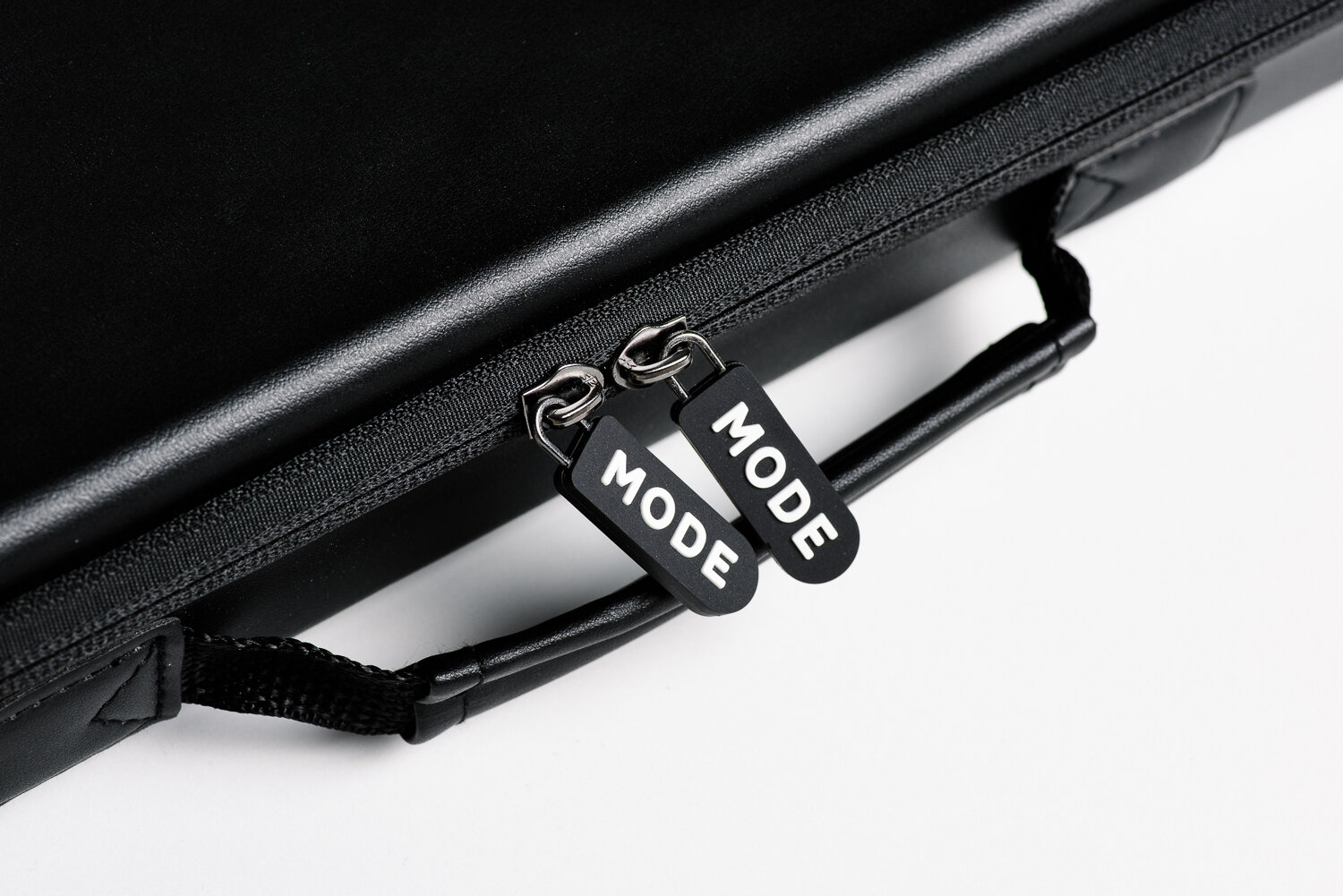

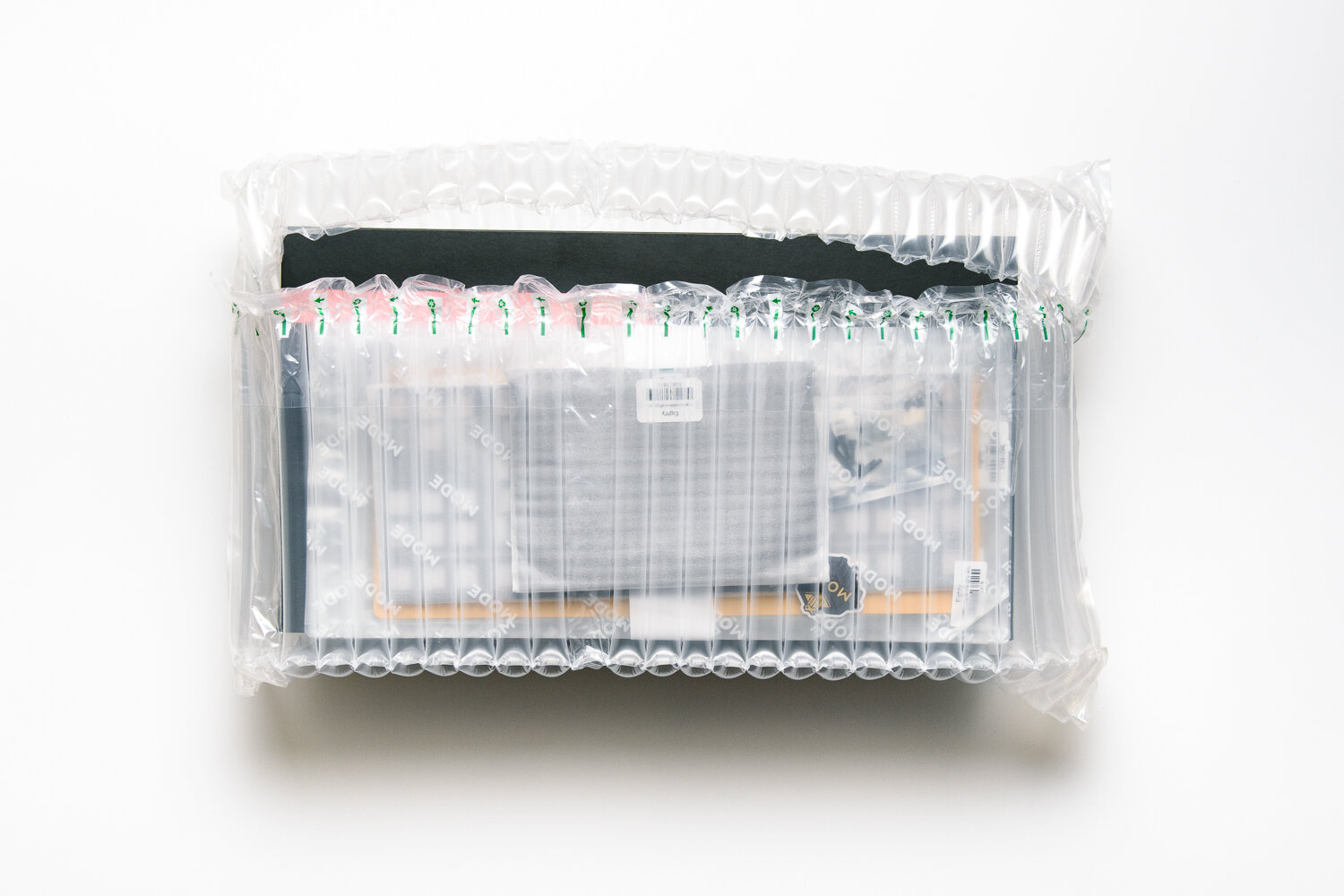
When it comes to the unboxing experience, Mode does quite a bit to make you feel that you’ve just purchased a premium product. From the moment you cut open the cardboard shipping box, you’ll notice that the keyboard box is protected by a hefty bubble sleeve. (This stood out to me because the collaborative laptop between ACRONYM and ASUS utilized similar reusable packaging called AIRPCS).
Anyways, the keyboard comes in a black box, while the rest of the internals are contained in one of four translucent ziplock sleeves. When you pop open the magnetic lid of the black box, you’re greeted by a nice branding message and a hard shell carrying case. Inside the case, the keyboard is shrink-wrapped to prevent scratches; you’ll also notice that it’s held together internally using a plastic placeholder screw (potentially to keep the actual assembly hardware pristine).
The full included parts list comprises the aluminum housing, aluminum plate, PCB, bottom foam, plate foam, daughterboard, rubber feet, screws, hex keys, hard shell carrying case, microfiber cleaning cloth, and a sticker. The hard shell case is decidedly premium, featuring custom Mode branded zippers, a soft velvet interior, and a carrying handle.
Overall, the Mode Eighty makes a fantastic first impression with its delightful unboxing experience. Some people might find all the custom branded packaging wasteful, but the included ziplock sleeves are quite durable and can be used to store additional PCBs and plates when not in use. Ultimately, if you are someone who really appreciates attention to detail, you will be pleased.
Design and Construction
The Mode Eighty introduces two interesting design choices in terms of its construction – the “stack-mount” system and the fact that the entire assembly is accessible via three screws to easily swap internal builds.
The stack-mount system is slightly controversial because foam is a necessary structural component of the build. In the custom keyboard community, many purists tend to prefer letting the internal cavities of the keyboard determine its sound profile. Foam is often looked at as more of a stopgap solution to reduce unwanted resonance (more to come on sound and feel later in the review).
To further explain how the stack-mount system works, it is essentially a self-contained sandwich of all the components within the case – supported by foam. The bottom case secures to the top case via interlocking alignment tabs on the bottom edge and three screws that go into posts in the top case (positioned between the F row and the alphas). The PCB/plate assembly is held in place by upward pressure from the bottom case foam. A piece of plate foam is also included, but this is fully optional.
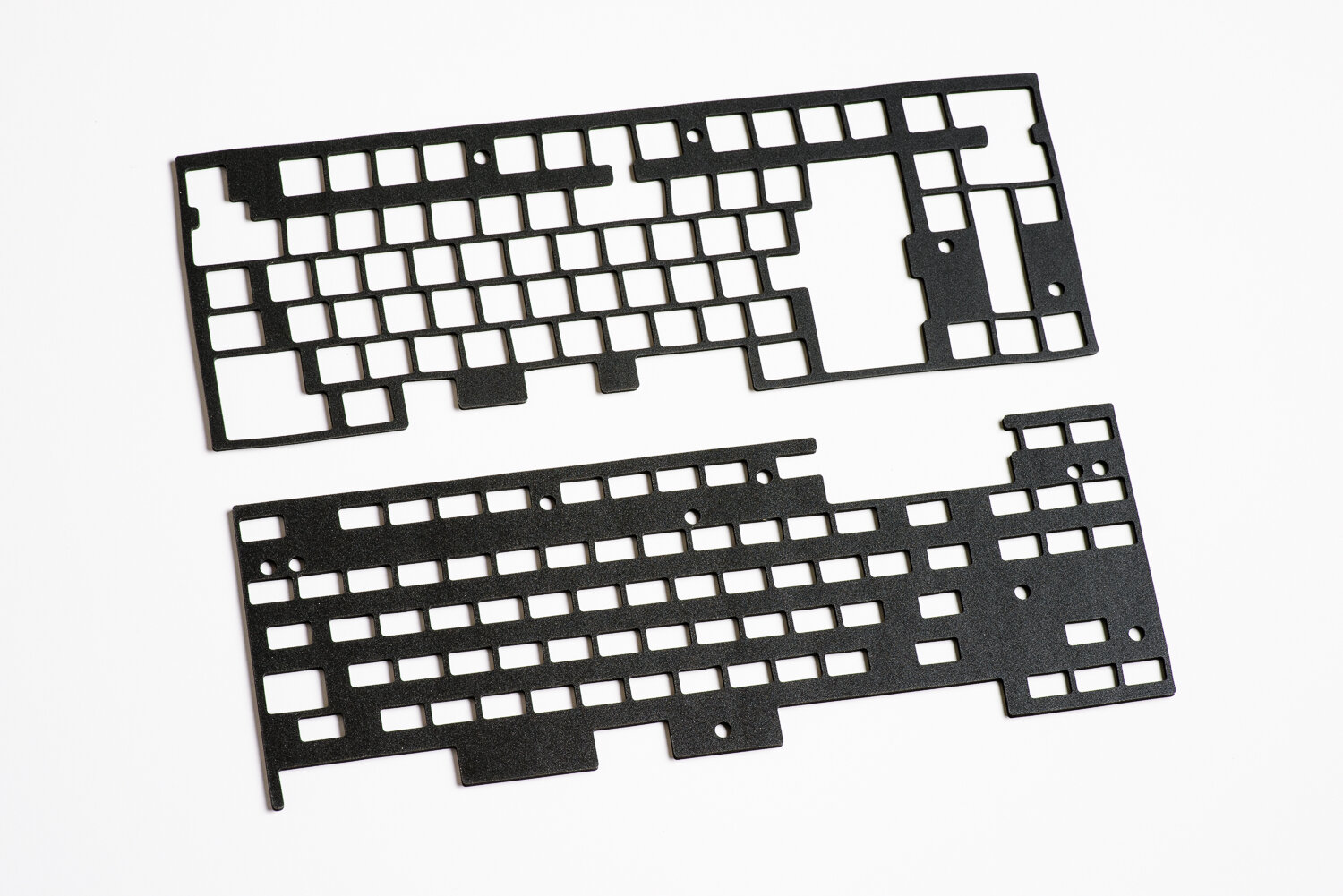
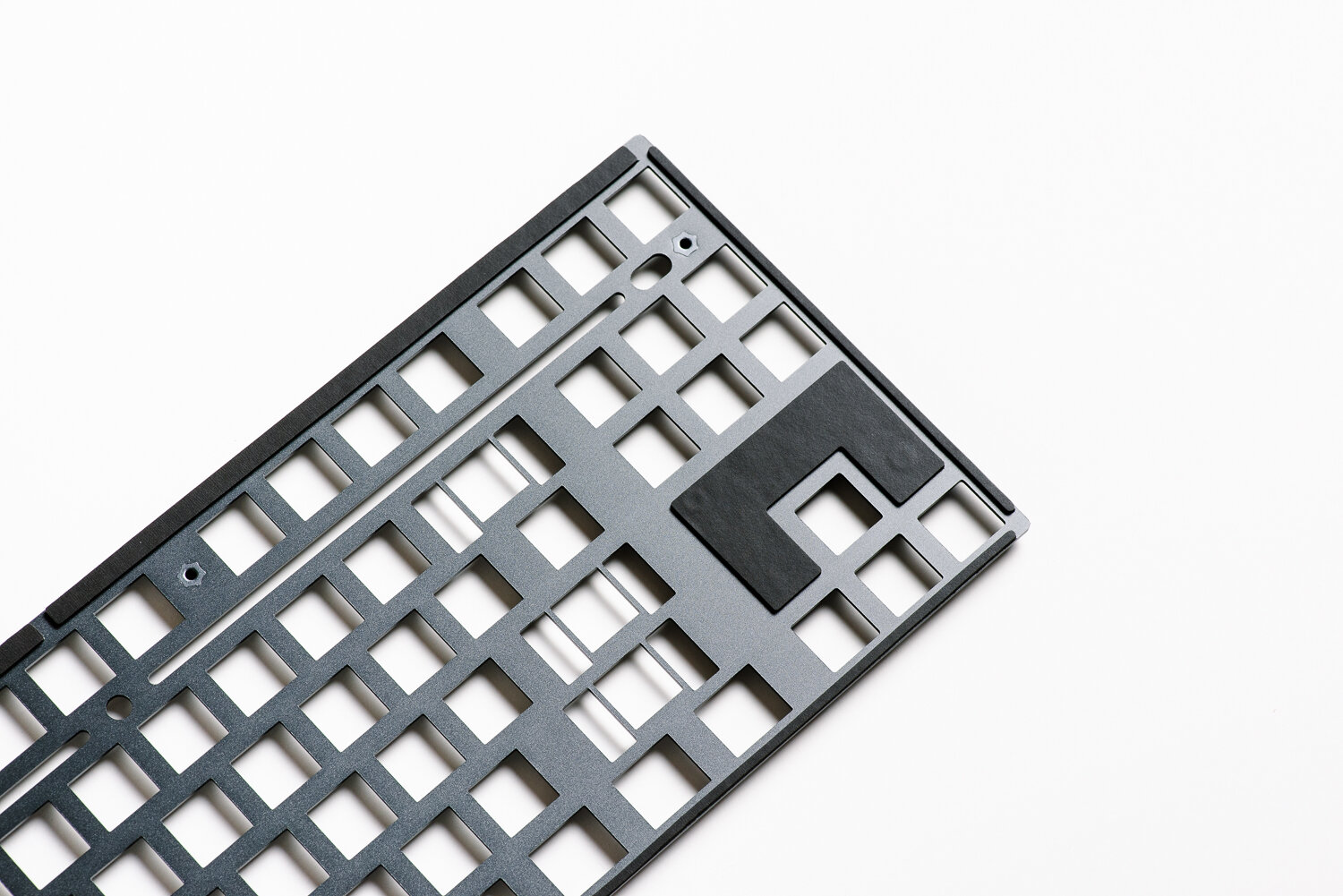
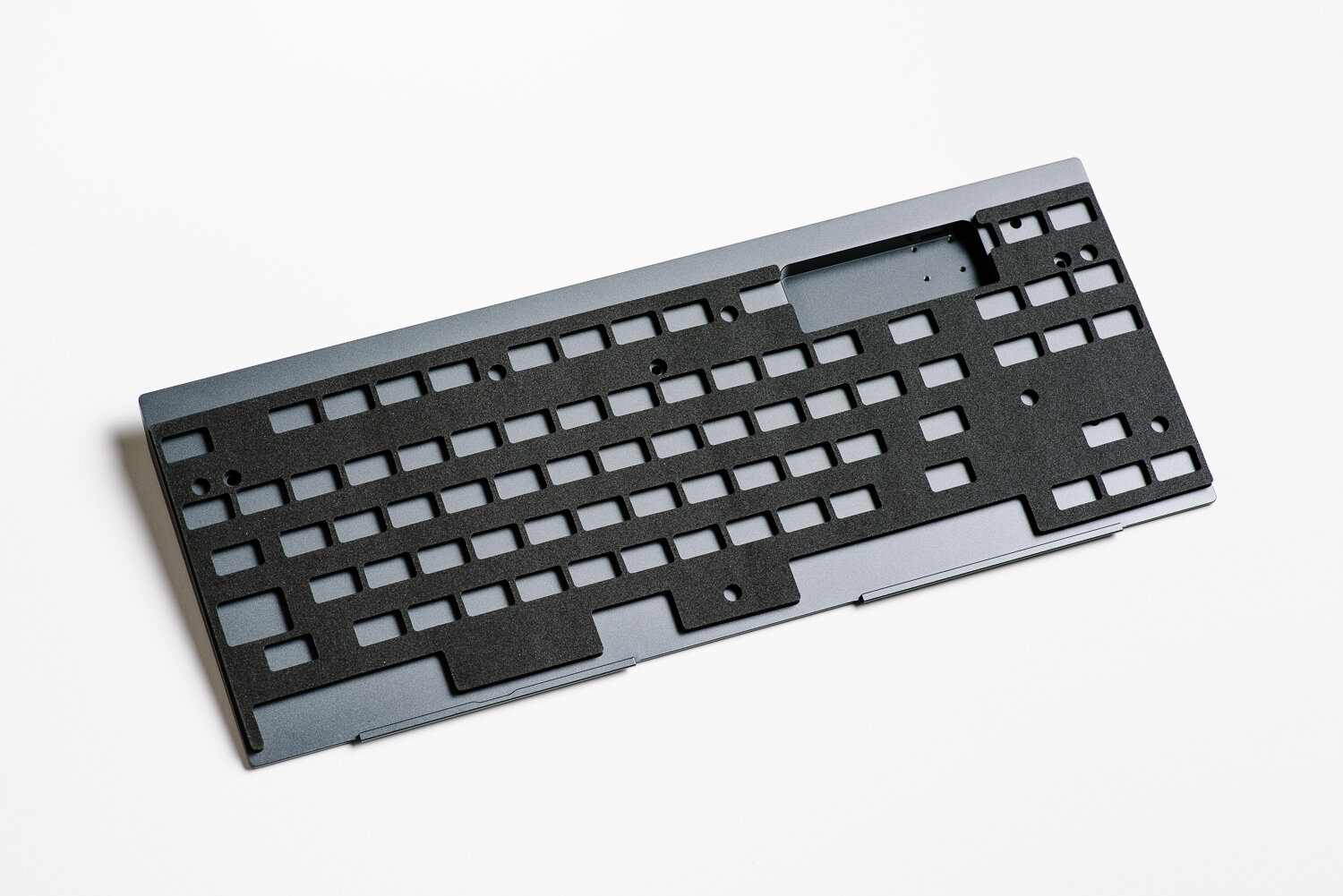
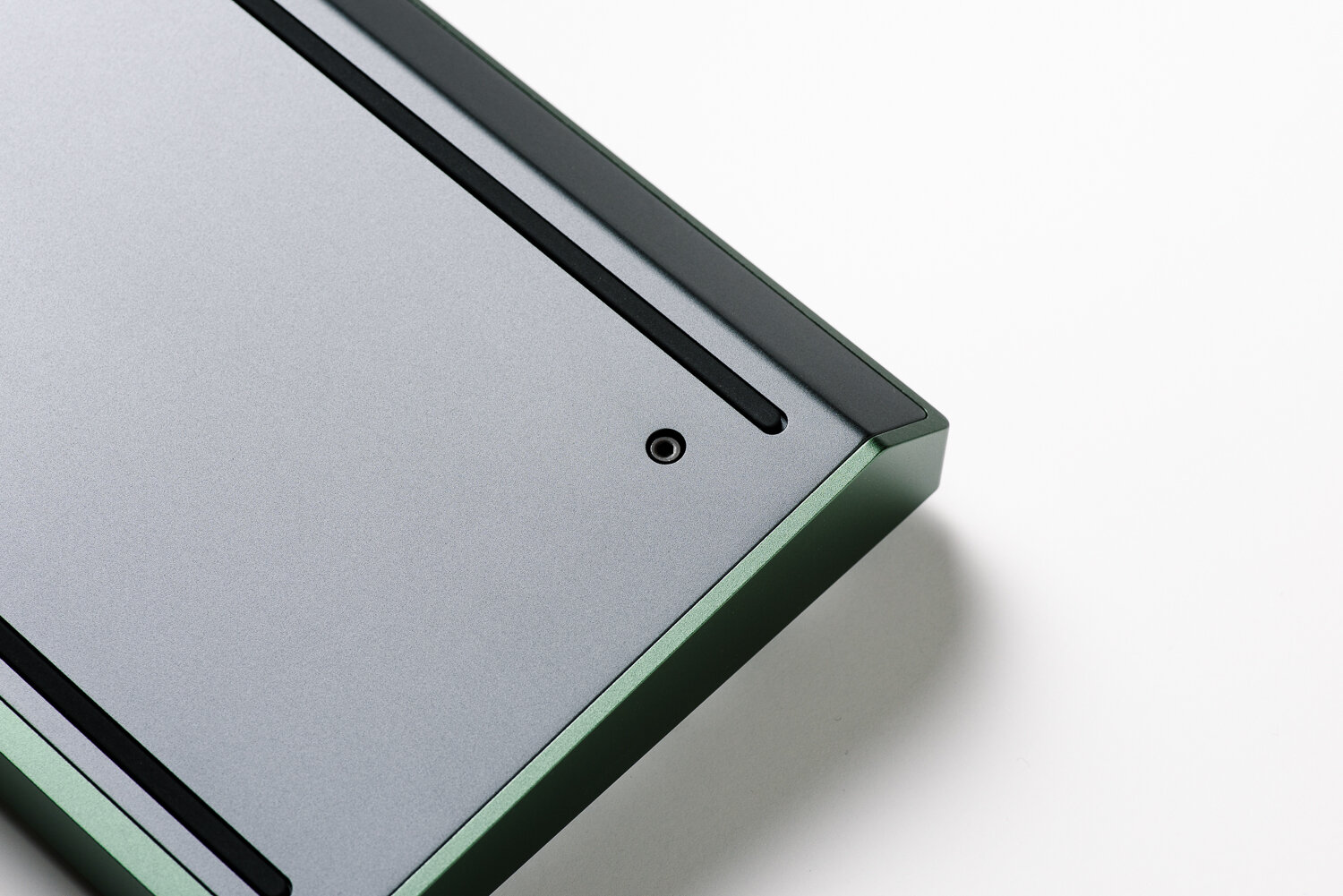
On its own, the Poron foam used throughout the keyboard is very soft and flexible. When assembling the keyboard and screwing it shut, you’ll feel a good amount of pressure as the Poron compresses for the first time. Due to the nature of the mounting style, there is no room for any space below the PCB and bottom case. The thick aluminum and brass plates feature thin Poron strips around the perimeter of the top side. With the FR4 and polycarbonate plates, this is optional. The plates all measure around 1.5mm (although the polycarbonate one is closer to 1.3mm) and have flex cuts between the F row and alphas. On plates intended for the solder PCBs, Mode includes large stabilizer cutouts so that you can access the PCB-mount stabilizers without needing to desolder the entire board.
If you’re using the hotswap PCB with the aluminum plate, you can attach the two together using eight screws and standoffs build into the underside of the plate. This simply maintains the distance between the plate and PCB to facilitate the swapping of switches. The other plate options do not feature standoffs, as they were designed with the solder PCB in mind. When using the hotswap PCB with the plates intended for solder builds, you also want to make sure to install most of the switches into the plate first before you combine it with the PCB. This will ensure that the switches sit flush with the plate and that the plate does not slide down toward the PCB as you install them.
The bottom case features a machined area for the daughterboard that allows the USB-C port to sit lower on the back side of the case. The daughterboard is held in via four small screws and connects to the perpendicularly mounted JST connector on the PCB. On the exterior of the bottom case, you will find two long recessed slots for the included rubber strip feet. They do a great job of keeping the keyboard in place on your desk/deskmat, and I greatly prefer these strips (both visually and functionally) to individual Bumpon feet.

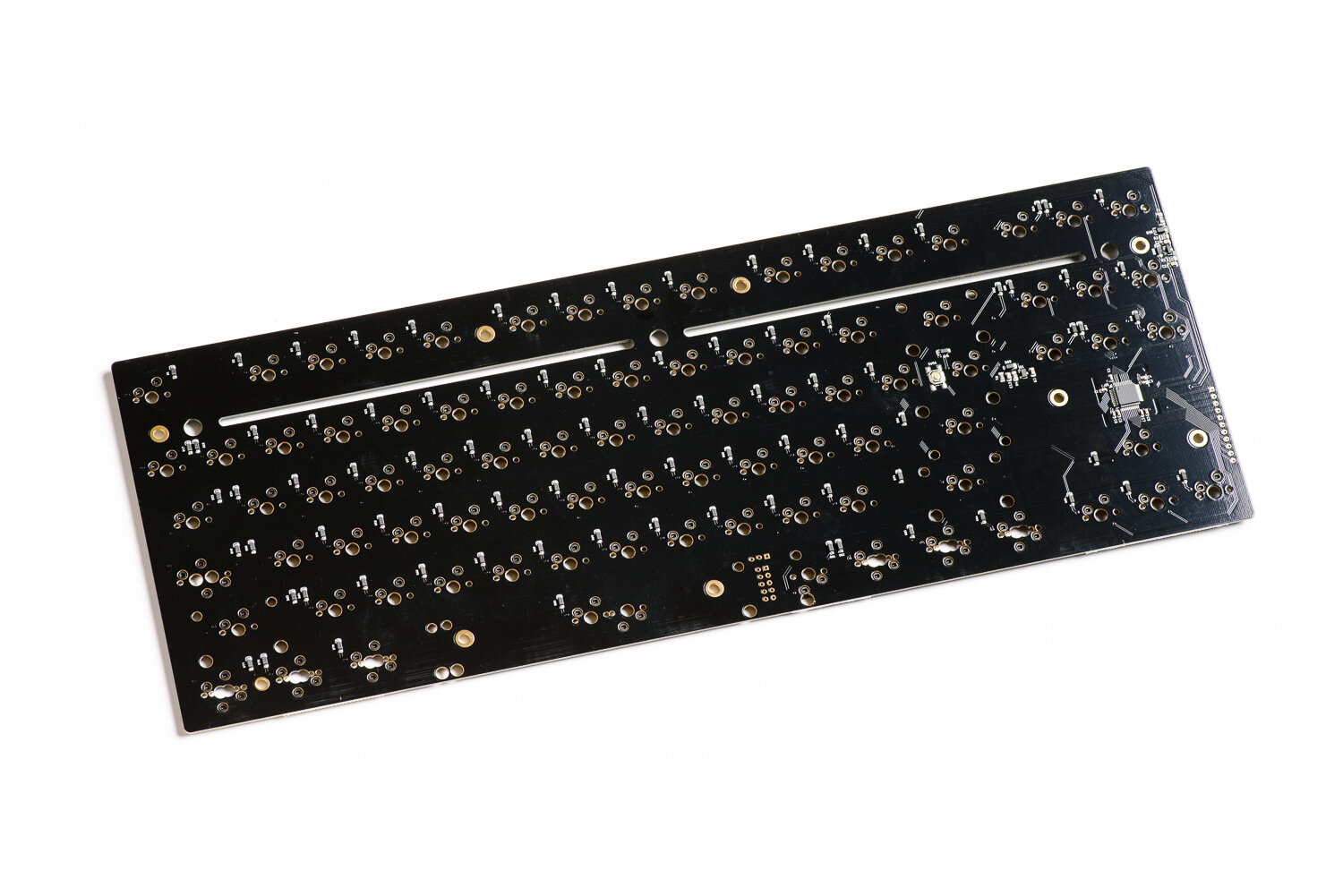
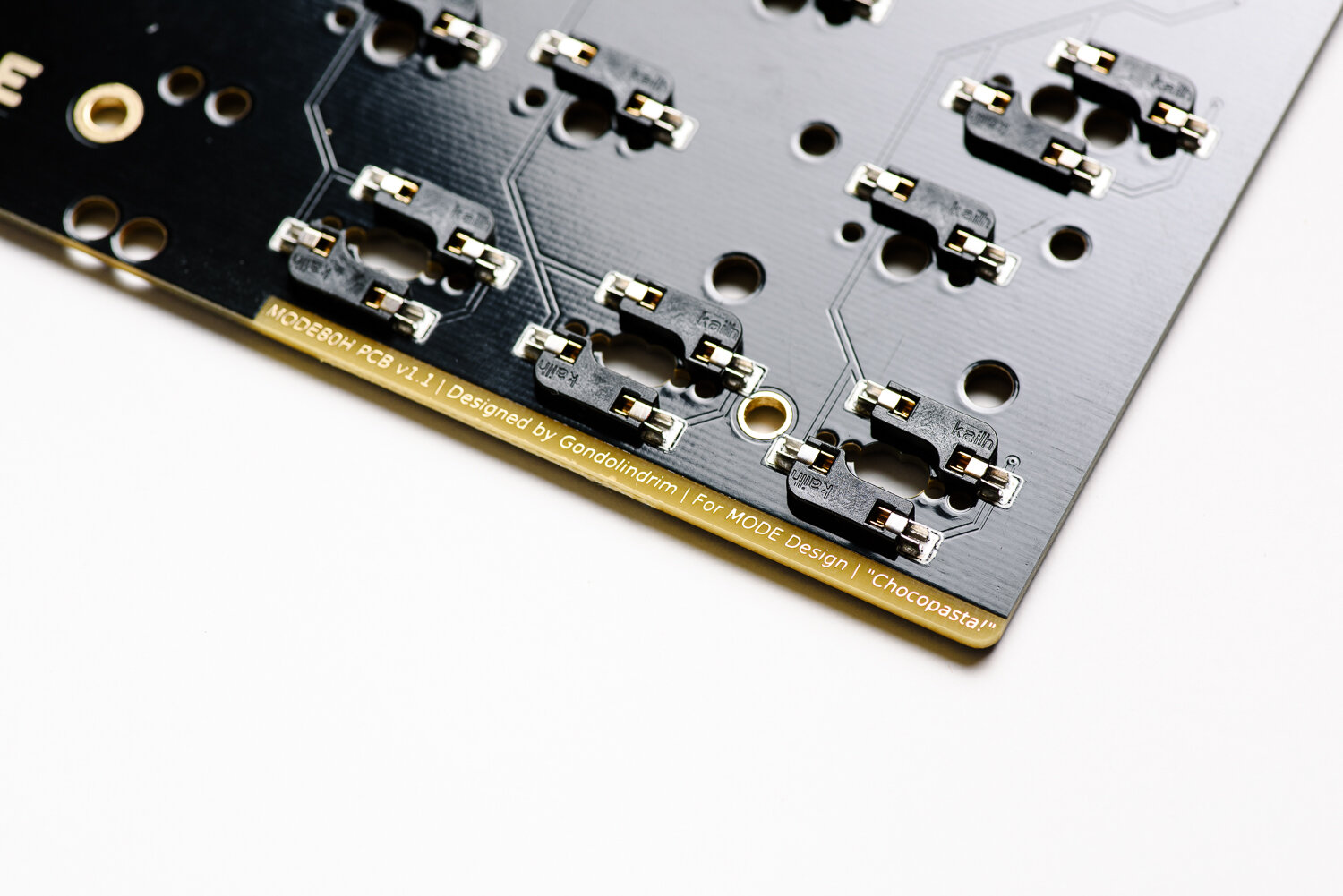
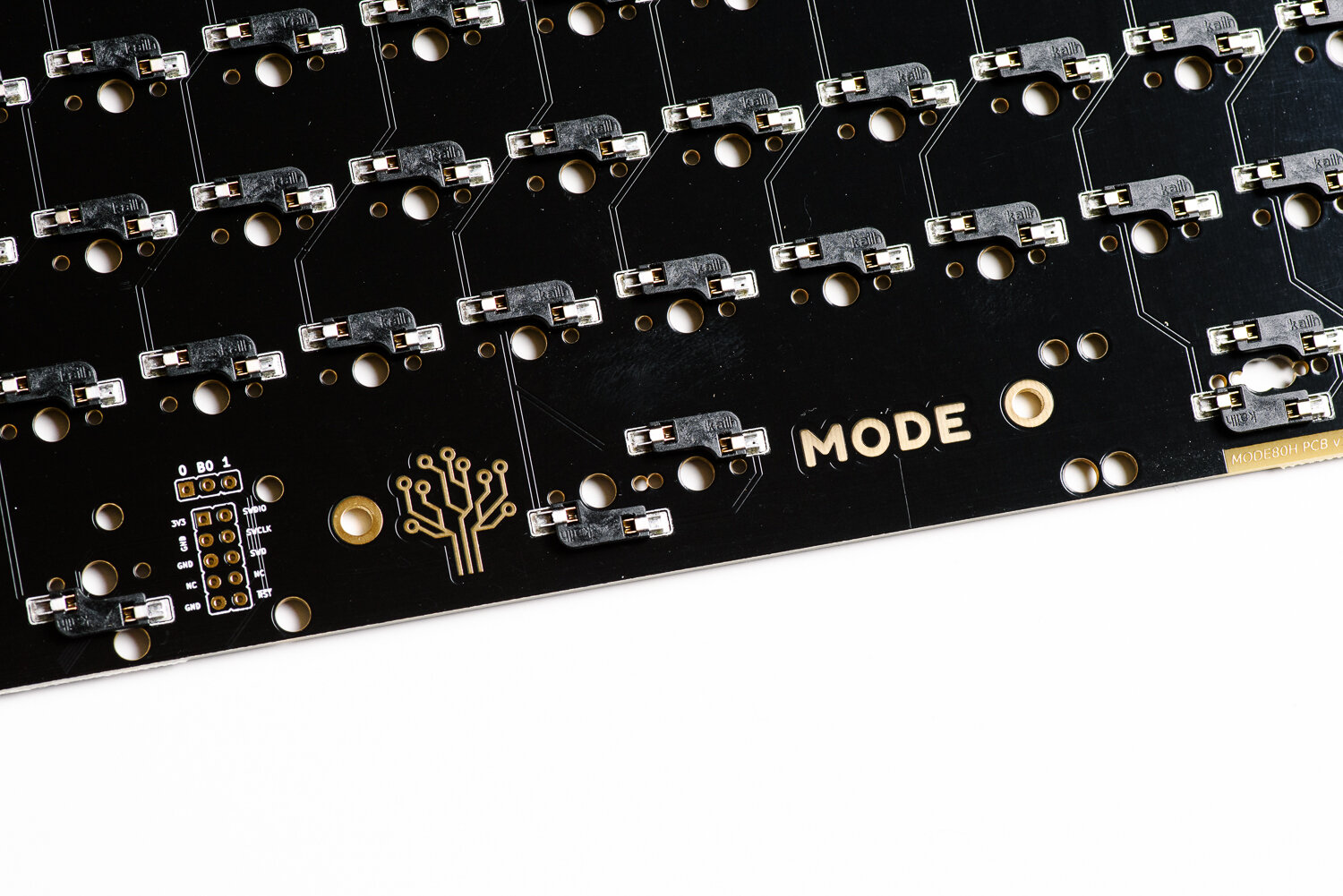
The PCB is designed by Gondolindrim, comes in either hotswap or solder variants, and features a nice glossy black finish. The hotswap variant uses Kailh sockets with 5-pin support in the correct south facing orientation for most of the keys (more on this in the Layout section). The exclusion of RGB should come at no surprise in a clean design such as this. The PCB also features both MODE and Gondolindrim branding at the bottom of the back side.
I assembled and disassembled the Mode Eighty more than half a dozen times over the course of the review, and the process is very straightforward. My only gripe is that the JST connector can be a bit awkward to get out. Good practice generally dictates that you pull on the connector rather than the cable itself when unplugging something. However, the actual plastic bit of the connector doesn’t have much of an edge for your fingernails to grab onto and loosen the connector. I ended up unscrewing the daughterboard from the base a few times in order to get a better grip on the connector.
The Mode Eighty measures 19mm tall in the front, 33mm tall in the back, 358mm wide, and 150mm deep. The typing angle is 5.5 degrees. Fully built, the keyboard weighs approximately 4 lbs, 10.5 oz. For a keyboard in the TKL form factor, I’m a fan of this weight range. It’s heavy enough that it’s not going anywhere on your desk, but it also doesn’t feel heavy for the sake of being heavy (as is common with many premium keyboards).
Aesthetics and Details
The design of the Mode Eighty is about as minimal as it comes; I get the sense that “less is more” was a guiding principle in its development. Some might call the design boring and safe, while others will describe it as minimalistic and professional. I, for one, actually rather enjoy the clean, straightforward lines of the keyboard, especially when paired with a nice anodized color like green or navy.
Speaking of colors, the Mode Eighty is available in six different combinations (top/plate/base) – Viridian (green/grey/grey), Deep (navy/silver/silver), Imperial (red/grey/red), Deco (grey/gold/gold), Monochrome (e-white/grey/grey), Celestial (e-white/gold/gold). The two e-white colors will cost an additional $10.
The Viridian colorway is more of an emerald green than viridian as the name suggests (viridian tends to be more of a blue hue). I absolutely love the green anodization, and think it pairs particularly well with keycap sets that utilize white, black, or any sort of earthy tones. Under light, the anodized green surface transitions between darker and lighter shades. The bottom of the keyboard and the default aluminum plate are also a dark grey that looks much more sophisticated than plain black.
The face of the keyboard has no real defining characteristics, but the proportions are fairly classic. The side bezels are relatively thin at 5mm, the top bezel is about the height of a row of keys at 20mm, and the bottom bezel comes in at around 8mm. The tolerances around the F row are very tight, so I would recommend taking the PCB/plate/switch/keycap assembly out if you need to remove that row of keycaps (so as to avoid scratching the inner edges of the bezel). All of the top edges of the keyboard are slightly chamfered, so they look fairly hard but don’t feel overly sharp. The corners are cylindrical with small radii, creating a similar effect.
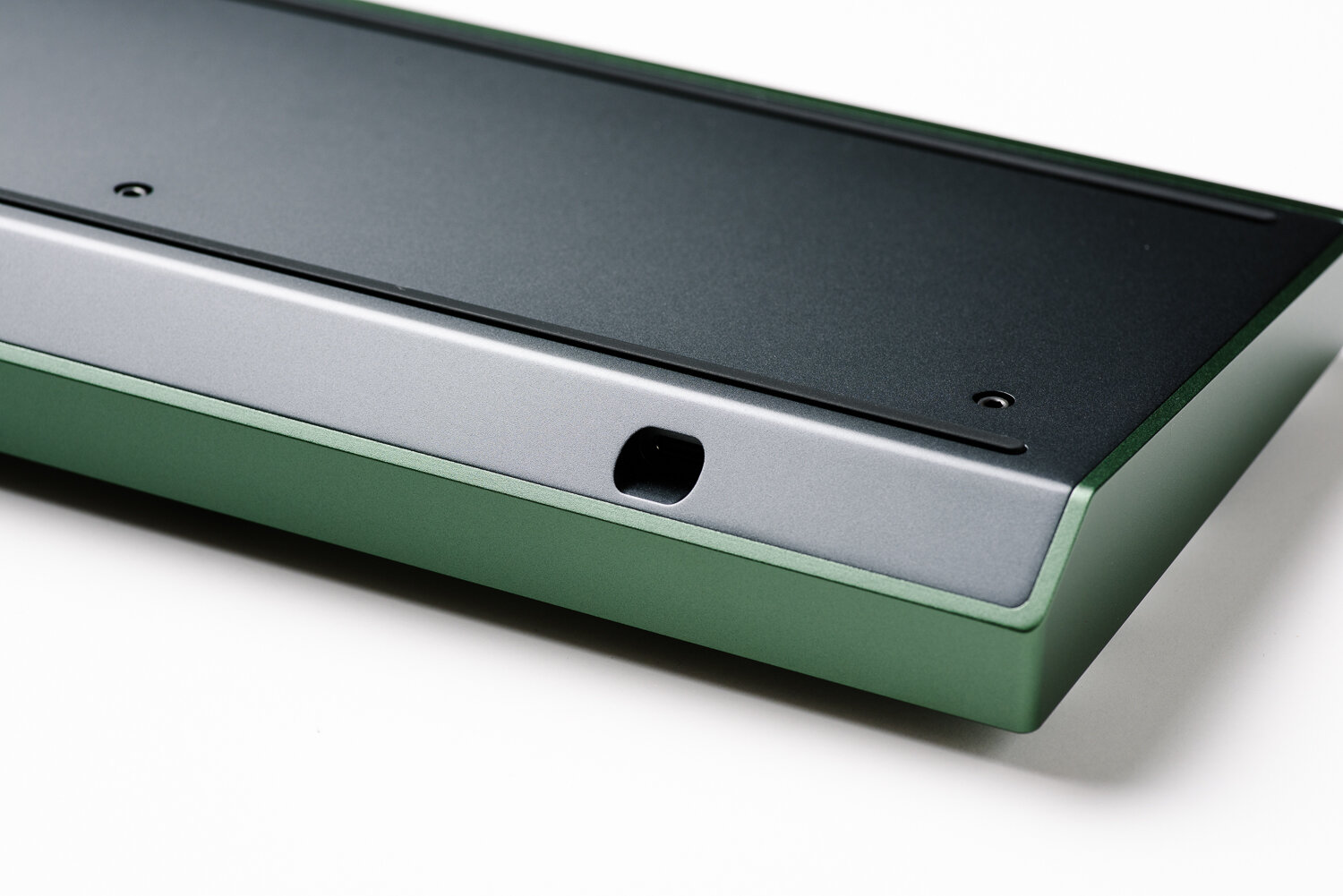
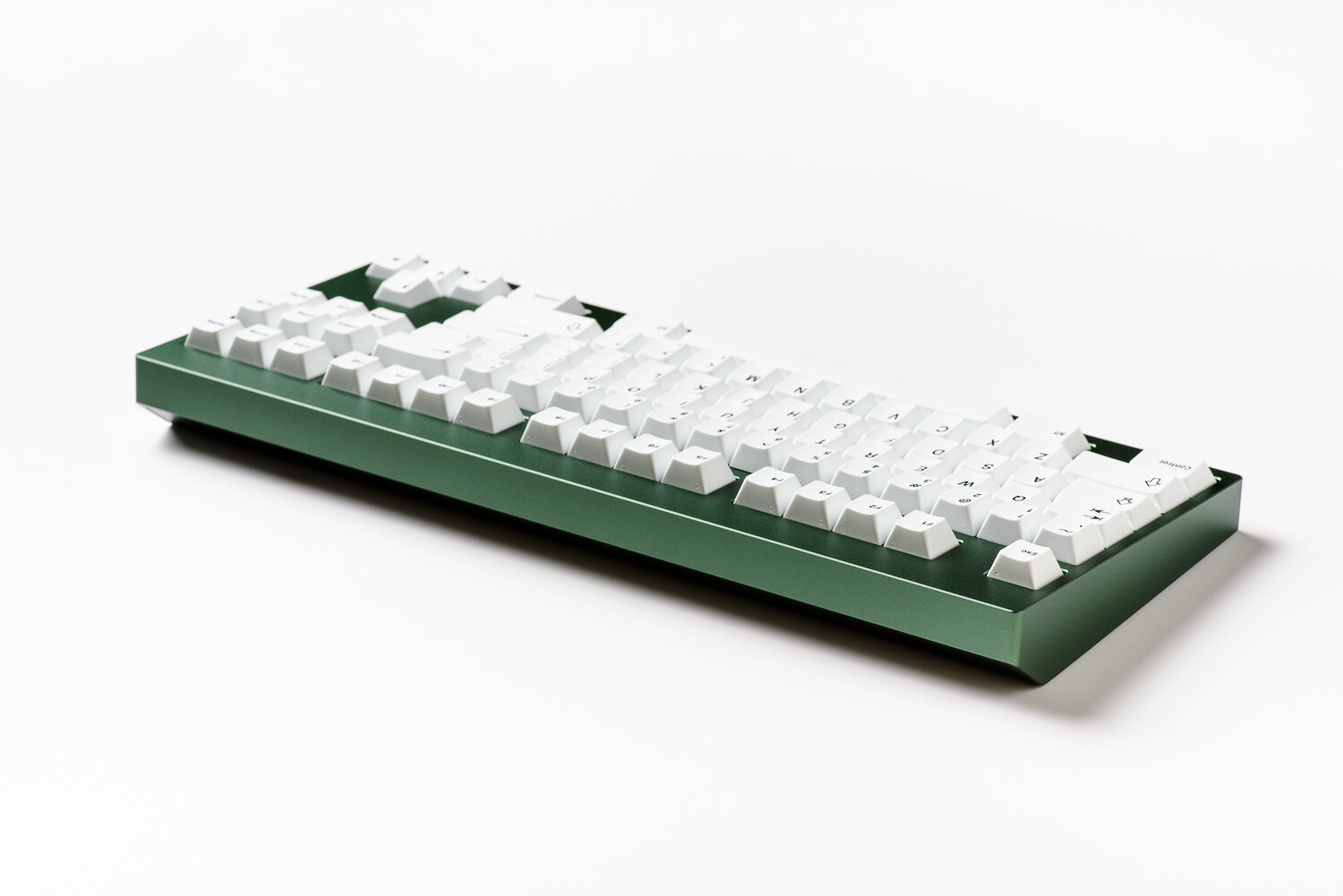
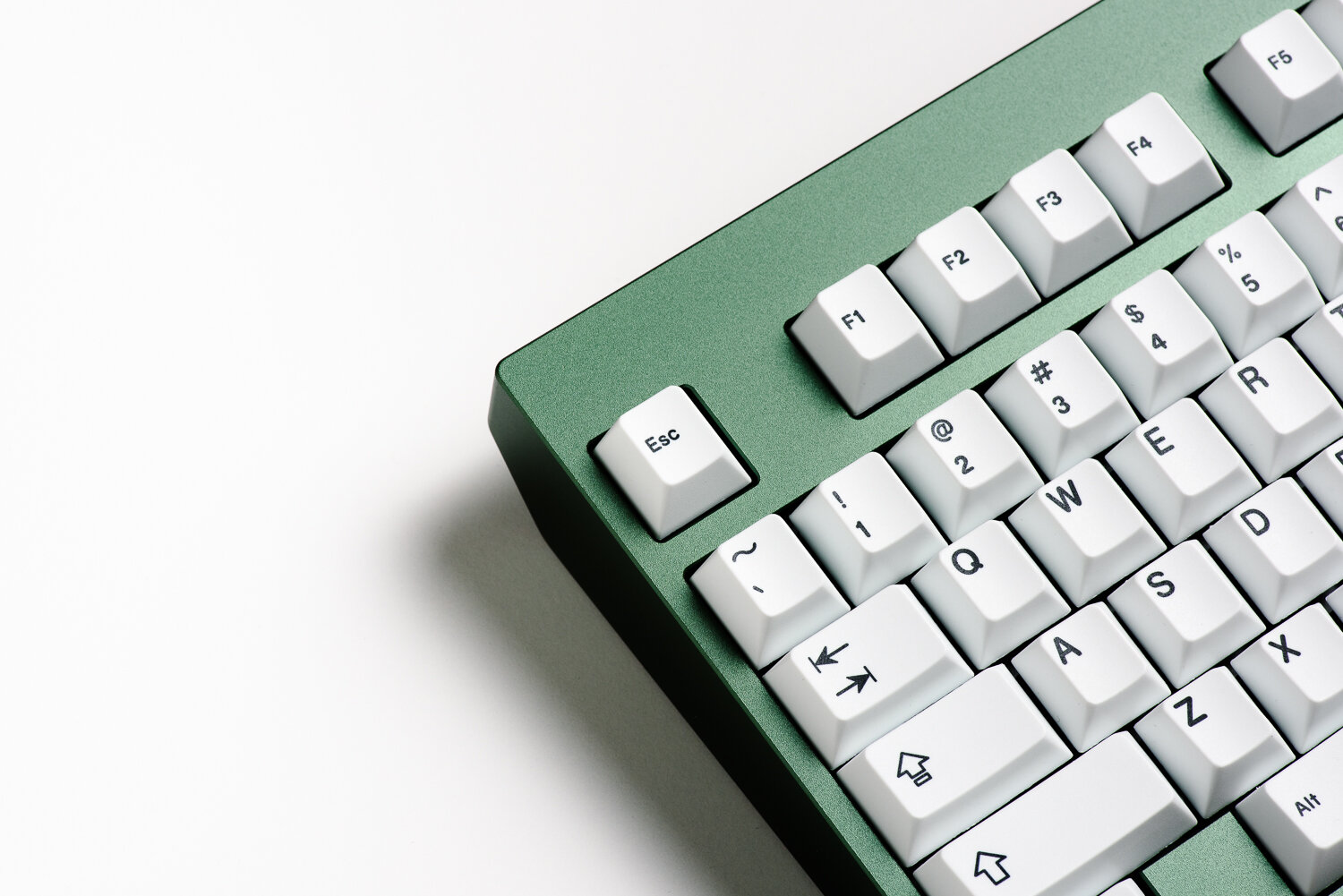
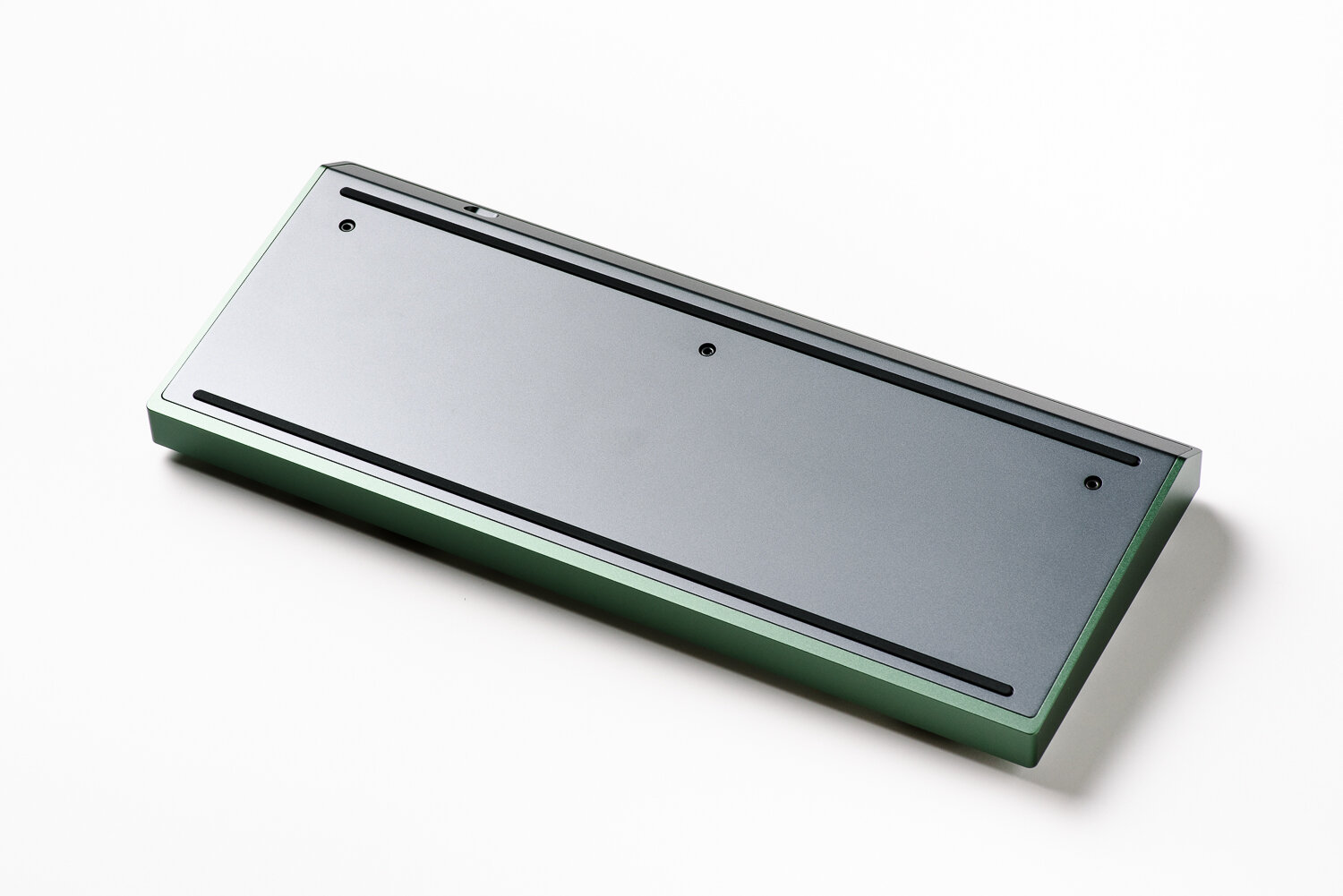
The largest defining characteristics of the Eighty are seamless sides and the cut in the lower half of the rear. As a result, the side profile and rear three-quarters will be the most visually interesting angles. The design in this implementation is unique, but one might also say the rear cut draws inspiration from the likes of the Keycult No. 2’s bottom and Ai03’s recurring wedge shape. The back side is completely smooth thanks to the placement of the USB-C cutout. Located between the F12 and Scroll Lock keys, the daughterboard allows for a very low USB port placement. Sitting fairly flush with the table, the majority of the cable connector is concealed by the recessed port and the rear cut. This looks very clean, but as a result, you’ll likely have to grab either the heatshrink behind the connector or the cable itself when plugging/unplugging it.
The bottom case is also very nondescript with its contrasting grey color. The painted hex screws are a nice touch that elevate the look and feel significantly over bare Phillips screws. Renders on the product page depict a small etched MODE logo on the bottom case; however, the actual units that shipped do not feature this branding (it did not turn out well on Mode’s prototypes). Looking around the edges of the bottom case, the top case lines up well without much of a gap.
Visually speaking, I really like the clean lines of the Mode Eighty. Functionally speaking, it can be a tad difficult to lift the keyboard up and move it around on the desk when needed. Since the front and sides of the board are completely vertical with no indentations, you kind of just have to squeeze in with your fingertips and get enough friction to lift the board. You could technically grab the rear lip, but the front side is still completely vertical with no indentation and has even less surface area to grab onto.
Plugging and unplugging your USB cable into the Eighty also involves a bit of feeling around with your fingers, as it’s not the easiest to lift the keyboard toward you to visually identify the location of the USB port. Whether you grab the back edge or the sides to lift it up, it just ends up being more awkward to plug the cable in by uprighting the keyboard rather than just feeling around the back while it’s laid flat on the table.
Build Quality
Quality control from Mode Designs appears to be very good based on this singular copy of the Eighty. The anodization is excellent to my eyes and fingers, with no irregularities in evenness or texture. The seams line up well and there are no fitment issues in assembly. Everything is nicely protected in shipping as well and arrives in perfect condition.
Finishing on the plates is fairly nice for the most part as well. The anodization on the aluminum plate has no real flaws. The PVD mirrored finish of the brass plate is also good, although there are some horizontal polishing marks visible under direct light. The FR4 plate features a matte black surface, gold outlines around all of the cutouts, and MODE branding just above the arrow keys. The least refined plate in the lineup (at least visually) would have to be the polycarbonate plate. It has an uneven looking glossy black finish that is easily scratched and almost feels aftermarket compared to the fit and finish of the other plates. That said, none of these are visible once your keyboard is assembled.
Switch cutout tolerances are fairly tight on most of the plate options. I found that switches sat a bit loosely in the brass plate, but there were no stability issues once the switch pins went into the PCB.
Typing Feel and Sound
Regardless of the plate material used in the Mode Eighty, the word I would use to describe its sound is “creamy.” The sound that instantly comes to mind when typing on the Mode Eighty is that of Jenga blocks tapping together. The alphas all have a very consistent sound that leans on the side of being “clacky,” while the number row and function row are notably deeper sounding and “thockier.”
So is the mandatory inclusion of foam a dealbreaker? Not necessarily. I don’t think the sound profile is as muted as I originally expected, but it does seem to be pushed more toward the surface of the keyboard. This doesn’t come as much of a surprise either, as sound simply doesn’t have much ability to bounce around the chamber below the PCB (not that there was much empty space to begin with, even without the bottom foam).
In an attempt to explain this phenomenon, I will make an analogy to the headphone world. One might compare the Mode Eighty to a closed-back headphone rather than an open-back set. Closed-back headphones often have a more focused sound (sometimes to the point of feeling more congested), whereas open-back headphones can sound a bit more spacious and airy. This is simply a function of allowing the sound to breathe a bit more.
But let’s take a step back and get out of the trenches of keyboard acoustics for a second. Many people simply want something that has a nice low-frequency sound without any offensive or unpleasant sound characteristics. I think the Mode Eighty provides just this and will be quite pleasing to most ears. For those who have experienced a wide variety of builds and have already made up their mind on foam in keyboards, this may not be the one. And that’s perfectly fine; there are plenty of different keyboard designs out there that can fit each person’s acoustic preferences.
The Mode Eighty comes with an aluminum plate by default ($37 if you need to buy an additional one), but you can order quite a few other options separately – FR4 ($30), polycarbonate ($30/35), POM ($35), brass ($50), and carbon fiber ($55/60, limited). I will be covering my impressions with all of these materials in the context of the Mode Eighty, with the exception of POM and carbon fiber.
The overall impact of the plate material on transforming the sound of the Mode Eighty is a lot more subtle than I had originally anticipated. With that said, FR4 is the most interesting sounding plate to me in the Eighty. It gives the keyboard a brighter and more vibrant sound signature overall, with a more pleasant resonance than some of the other materials. By comparison, the aluminum plate provides a bit more muted of an experience overall. On the other hand, polycarbonate has a more pleasant sound than aluminum but feels a little duller than FR4. The FR4 plate simply sounds poppier than the more subdued polycarbonate one. Brass had a higher pitch and less resonant sound, which I didn’t find to be as agreeable in the context of the Mode Eighty. Regardless of the plate material used, I felt that the mounting style was always in the foreground of the sound profile.
Now, let’s talk about the typing feel – similar to the sound, the Mode Eighty is consistently firm regardless of the plate material used. The bottom out is not harsh, but there isn’t much flex to speak of at all. Prior to assembly, you can notice a good amount of flex with the FR4 plate and polycarbonate plate (the latter is insanely bendy on its own). However, once assembled, you really can’t get the plate/PCB assembly to flex much even if you push down quite hard. It seems that the mounting style just doesn’t allow for much vertical movement or create the opportunity for what can be considered a bouncy typing experience. As a result, changing the plate material will impact typing feel more in terms of how vibrations are dissipated upon bottom out (rather than actual flexibility of the plate/PCB assembly).
Out of all the plate materials I tried in the Mode Eighty, the FR4 plate felt the best to me (second place goes to aluminum, third goes to polycarbonate, and last goes to brass). In the context of the mounting style and case, the brass plate is simply firmer than it really needs to be. The polycarbonate plate is not a bad option, but it just doesn’t provide as satisfying of a bottom out feedback as the FR4 (and even aluminum) plate. Compared to the aluminum plate, the FR4 plate takes away some firmness, allowing for less fatigue over long periods of typing. For those who enjoy additional firmness, you can install the optional center foam between the plate and PCB as well. I preferred the sound and feel without this piece included, but your mileage may vary.
The relatively low 5.5 degree typing angle of the Eighty makes it very comfortable and nicely compatible with higher profile keycap sets as well.
Layout and Programmability
The Mode Eighty is compatible with both WKL and WK tops. As with all other keyboards in these variants, the WKL variant uses a 1.5U and 7U bottom row while the WK uses a 1.25U and 6.25U bottom row.
Since the hotswap PCB is compatible with both 6.25U and 7U bottom rows, each bottom row key has two hotswap sockets adjacent to each other in opposite orientations. If you opt for the WKL variant with the 7U bottom row, the switches under and to the left of the spacebar will be flipped and north-facing. Similarly, the hotswap PCB supports both stepped and standard caps lock keys. Utilizing the standard caps lock key will cause the switch to be north-facing, whereas the stepped caps has the switch in a south-facing position. I did not notice any real interference issues with the bottom row mods. Since the caps lock key is in the R3 profile, however, there is some inevitable interference when using the non-stepped caps lock key. In practice, this is not too noticeable and many keycap sets include a stepped caps lock these days.
If you opt for a solder PCB, you are granted the additional options for split right shift and split backspace (on top of the two bottom row options and standard/stepped caps lock).
VIA and QMK are fully supported out of the box, making for easy key remapping. On a TKL, I enjoy setting the top right cluster of keys to act as dedicated volume, media playback, and brightness controls.
Availability and Competition
One advancement Mode brings to the table is their method of fulfilling orders. Rather than making customers wait for 6-12 months, they put in their orders ahead of time to shorten fulfillment times to 1-3 months. For both the customer and the vendor, this seems like a happy medium between a standard group buy and an in-stock sale.
In terms of recent competition in the high-end TKL space, some usual suspects are the Geonworks F1-8X ($330, Korea-only), Monokei KFE CE ($450), and RAMA Works U80-A ($400-480). On the slightly more budget side of things are the KBDfans KBD8X MKII ($329-389) and CannonKeys DevastatingTKL ($310).
In the context of these other keyboards, the Mode Eighty is certainly not cheap – even after its price reduction from $690 with the Founder’s Edition to $470 for the standard pre-order edition. You certainly do pay a premium for the branding/packaging efforts, and it is nice that the Eighty ships much faster than group buy boards. However, at this price tier, preferences in the nuances of sound and feel become truly critical, as do those rooted in styling. For instance, the F1-8X is known to provide a rather flexible typing experience, and the U80-A is recognizable for its design flair. Therefore, it becomes difficult to speak on relative worth in this segment of the market when so much boils down to preference.
Final Thoughts
My biggest takeaway from living with the Mode Eighty for a month is not about the keyboard itself but rather about Mode Designs as a new player in the custom keyboard space. Their attention to detail is remarkable on all fronts – branding and packaging, clean and professional design, fit and finish, ecosystem of accessories, the list goes on. In my mind, the message from Mode seems to be that they don’t just want to be another keyboard designer/manufacturer; they want to be the definitive option when it comes to a premium keyboard with minimalist aesthetics.
As for the Eighty itself, I am a fan of its simple design and ease of access/modularity. My minor grievances with the keyboard’s design are the ergonomics of moving it around on a table and the difficulty of unplugging the JST connector. The Eighty’s typing sounds are pleasant but not particularly exotic, just like the rest of the design. Bottom out feel is relatively compliant depending on your choice of plate material, but the overall typing experience is on the firm side regardless.
When it comes to future improvements, Mode seems to have already taken feedback about the stack-mount system to heart. Although nothing is confirmed about the upcoming Mode SixtyFive, the survey they put out hints at the inclusion of a traditional top-mount option to address potential sound and feel concerns. Furthermore, pricing seems to be more aggressive with a target of $280-320.
Given everything I’ve seen Mode Designs capable of thus far, I am truly excited for the brand’s upcoming projects – especially as they expand to other form factors.





